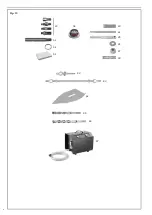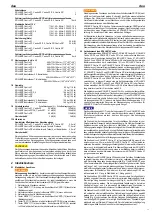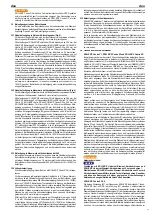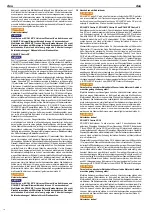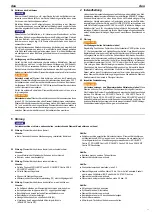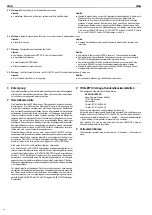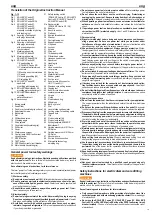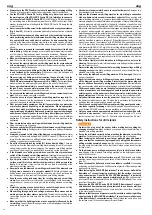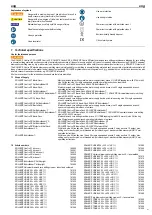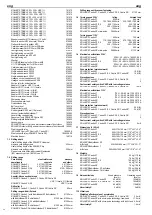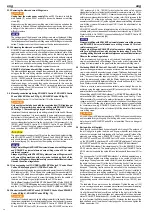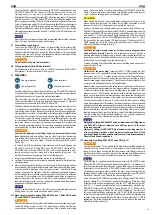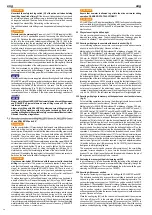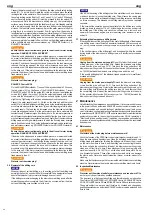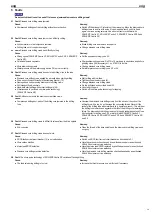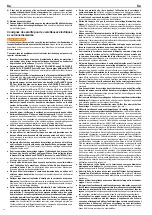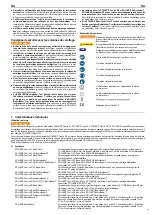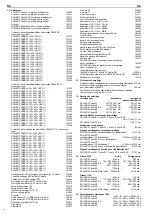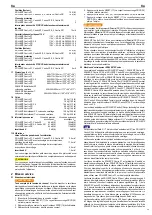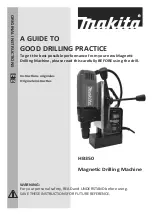
20
●
Always check the PRCD fault current circuit breaker before starting drilling.
The use of a fault current circuit breaker reduces the risk of electric shock.
●
Use the ROLLER’S Centro DP for dry drilling only. Never feed water into
the working area of the ROLLER’S Centro DP. It is forbidden to connect a
water hose to the ROLLER’S Centro DP. ROLLER’S Centro DP is not designed
for wet drilling and is therefore delivered without a PRCD fault current circuit
breaker. Impermissible wet drilling with the ROLLER’S Centro DP bears the risk
of electric shock.
●
Never loosen the locking screw for the earth cable under any circumstances
(Fig. 9 item 59). A correctly connected earth cable reduces the risk of electric
shock.
●
Only hold the diamond core drilling machine by the insulated grip surfaces
when performing work where the diamond core drilling crown could come
into contact with concealed electric cables or its own connecting lead.
Contact of the diamond core drilling crown with a live cable can also put metal
parts of the diamond core drilling machine under voltage and lead to electric
shock.
●
Check the areas concerned for concealed supply lines with a suitable fi nder
before drilling. Drilling can damage or sever gas or water pipes, electric cables
or other objects. Damaged gas pipes can cause explosions. Damaged water
pipes and electric cables can damage property or cause electric shocks.
●
Make sure that water can never get into the drive unit motor during opera-
tion. There is a risk of injury by electric shock if water should penetrate.
●
Do not use the electric diamond core drilling machine for overhead work
with a water supply. Penetration of water into the diamond core drilling machine
increases the risk of electric shock.
●
Never carry out overhead drilling or drilling to the wall when the drill stand
is only fastened by the vacuum plate. If the vacuum is lost, the drill stand will
come loose from the base and fall to the fl oor.
●
When carrying out drilling work that requires the use of water, feed the
water away from the working area or use a liquid collecting device, e.g. the
ROLLER’S water extractor unit (accessory Art. No. 183606). Such precautionary
measures keep the working area dry and reduce the risk of electric shock.
●
Cease operation immediately in case of leaks in the water supply and fi x
the leak. Do not exceed a water pressure of 4 bar. There is a risk of injury by
electric shock if water should penetrate the motor.
●
Do not operate the diamond core drilling machine in an explosive environ-
ment. Fumes or liquids can ignite or explode.
●
Clean the air vents of your diamond core drilling machine regularly. The
motor fan draws dust into the housing and a heavy accumulation of metal dust
can cause injury due to electrical hazards.
●
Wear personal safety equipment. Use full face protection, eye protection
or protective glasses depending on the application. Where appropriate,
wear a dust mask, protective gloves or special aprons which keep away
small grinding and material particles and protect you against sharp edges
and wear non-slip safety shoes to avoid injury from slippery surfaces.The
eyes should be protected against fl ying foreign bodies which occur in different
applications. Dust masks and respirators must fi lter the dust produced in the
application.
●
Wear ear protectors when working with the diamond core drilling machine.
Noise can lead to loss of hearing.
●
Use the counterholder (12) provided with the diamond core drilling machine
for hand-held drilling. Losing control of the diamond core drilling machine can
cause injuries.
●
Always be prepared for blocking of the diamond core drilling crown. Never
use stage 1 for hand-held drilling with ROLLER’S Centro SR. There is a risk of
injury from the diamond core drilling machine being torn out of your hand and
spinning round as the torque increases.
●
Do not lock the safety inching switch (21) for hand-held drilling. There is a
risk of injury from the diamond core drilling machine being torn out of your hand
and spinning round as the torque increases. The diamond core drilling machine
can then only be brought to a standstill by Protectoring out the mains plug.
●
If the diamond core drilling crown blocks, exert no thrust pressure and
switch off the diamond core drilling machine. Investigate the reason for the
blockage and remedy the cause of the diamond core drilling crown blockage.
●
If you want to restart a diamond core drilling machine that is stuck in the
surface or wall, fi rst check whether the diamond core drilling crown turns
freely. If it is jammed, it may not turn and this can lead to overloading of the
diamond core drilling machine.
●
Never put down the diamond core drilling machine until the diamond core
drilling crown has come to a complete standstill. Rotating diamond core
drilling crowns can make contact with the surface on which you put down the
tool, causing you to lose control of the diamond core drilling machine.
●
Keep the connecting lead away from the rotating diamond core drilling
crown. If you lose control over the tool, the connecting lead could be severed or
caught and your hand or arm could get into the rotating diamond core drilling
crown.
●
Protect the working area on both sides in case of through-bores. A drilling
core could fall out and injure persons and/or cause damage.
●
When drilling through walls and ceilings, make sure that persons and the
working area on the other side are protected. The diamond core drilling crown
can emerge beyond the bore hole and the drilling crown could fall out on the
other side.
●
Make sure that the building statics are not negatively infl uenced by the
core drilling. Consult the building supervisors or a static engineer to determine
and mark the core hole.
●
Check where the bore water fl ows to in case of hollow parts. Damages (e.g.
frost damage) could be caused.
●
Only use the diamond core drilling machine for dry drilling in connection
with a suitable safety vacuum cleaner/dust extractor. When working with
mineral building materials, e.g. concrete, steel-reinforced concrete, all types of
masonry, all types of screed, natural stone, a high degree of mineral dust containing
quartz is produced which is harmful to the health. Inhalation of quartz fi ne dust
is harmful to the health. The Directive 89/391/EEC on the taking of measures to
improve the safety and health protection of employees at work obliges the employer
to carry out an appropriate risk assessment at the employees place of work,
determine and evaluate the potential dust load and defi ne necessary protective
measures. The German technical ruling for hazardous substances TRGS 559
"Mineral Dust" defi nes in Appendix 1 that work with slitting and cutting machines
must be classifi ed in exposure category 3 if the effectiveness of the extraction
has not been proven. In accordance with EN 60335-2-69 a penetration level of
< 0.1 % is prescribed for sucking health hazardous dusts with an exposure limit/
work place limit (AGW) of > 0.1 mg/m³.For dry drilling of mineral building materials
at least one safety vacuum cleaner/dust extractor of dust class M, e.g. ROLLER’S
Protector M, should therefore usually be used in order to effectively extract the
resulting health hazardous dusts from machines. In addition, the respective national
safety provisions, rules and regulations valid for the application site must be
considered and observed.
●
Do not aim a liquid jet at the diamond core drilling machine, not even for
cleaning. Penetration of water into the diamond core drilling machine increases
the risk of electric shock.
●
Protector the plug out of the socket before making device settings or fi tting/
changing accessories. Many accidents are caused by accidental starting of
diamond core drilling machines.
●
Do not use the diamond core drilling machine if it is damaged. There is a
danger of accident.
● Never let the diamond core drilling machine operate unattended. Switch
off the diamond core drilling machine, Protector out the mains plug and
remove all hoses, if necessary, during longer work breaks. Electrical devices
can cause hazards which lead to material damage or injury when left unattended.
●
Children and persons who, due to their physical, sensory or mental abilities
or lack of experience and knowledge are unable to operate the power tool
safely may not use this power tool without supervision or instruction by a
responsible person. Otherwise there is a risk of injury due to false operation.
●
Only allow trained persons to use the power tool. Apprentices may only use
the power tool when they are over 16, when this is necessary for their training
and when they are supervised by a trained operative.
●
Check the connecting lead of the diamond core drilling machine and exten-
sion leads regularly for damage. Have these renewed by qualifi ed experts or
an authorised ROLLER customer service workshop in case of damage.
●
Only use approved and appropriately marked extension leads with a suffi -
cient cable cross-section. Use extension leads up to a length of 10 m with
cable cross-section 1.5 mm², from 10 – 30 m with cable cross-section 2.5 mm².
Safety instructions for drill stands
WARNING
WARNING
●
Protector the plug out of the socket before making device settings or
changing accessories. Many accidents are caused by accidental starting of
diamond core drilling machines.
●
Set up the drill stand correctly before mounting the diamond core drilling
machine. Correct assembly is important to prevent the risk of collapsing.
●
When fastening the drill stand to a surface or wall with plugs and screws,
make sure that the used anchoring is capable of holding the diamond core
drilling machine securely during use. If the surface or wall is weak or porous,
the plug could be Protectored out so that the drill stand comes loose from the
surface or wall.
●
Fix the diamond core drilling machine securely to the drill stand before
use. Slipping of the diamond core drilling machine on the holding device can
lead to loss of control.
●
Fix the drill stand to a fi rm, level surface or wall. The diamond core drilling
machine cannot be guided evenly and safely if the drill stand can slip or shake
(see 3.3).
●
Do not overload the drill stand or use it as a ladder or scaffold. Overloading
or standing on the drill stand can shift the centre of gravity of the stand upwards
and cause it to tip over.
●
When fastening the ROLLER’S Bohrständer T to a surface or wall with the
Bohrständer T vacuum fastening, make sure that the surface is smooth,
clean and not porous. Do not fi x the ROLLER’S Bohrständer T to laminated
surfaces, e.g. on tiles and compound material coatings. If the surface or wall
is not smooth, level or adequately fi xed, the ROLLER’S Bohrständer T can come
loose from the surface or wall.
●
Never use the ROLLER’S Centro DP if ROLLER’S Bohrständer T or a suit-
able drill stand from another supplier is fastened to a surface or wall by a
vacuum fastening. The drill stand can come loose from the surface or wall due
to the micro-pulse technology.
●
Make sure that the vacuum pressure is suffi cient before and during drilling
when fastening the ROLLER’S Bohrständer T to a surface or wall by means
of the Bohrständer T vacuum fastening. The drill stand can come loose from
the surface or wall if the vacuum pressure is insuffi cient.
eng eng

